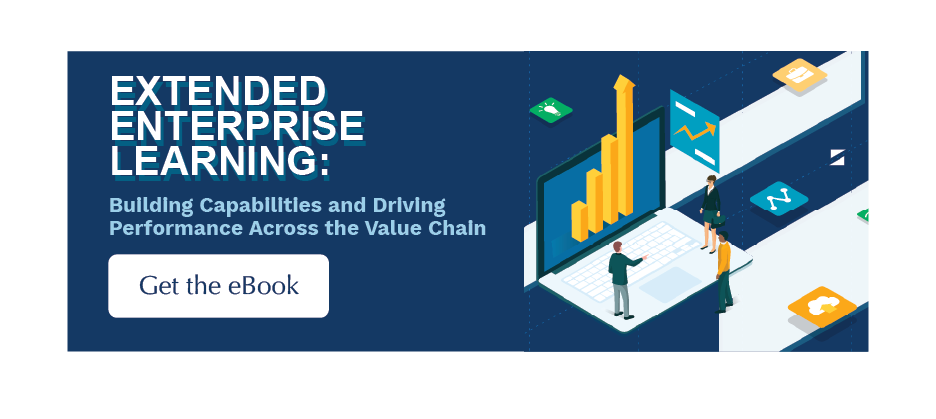Setting business goals is part of striving toward success. Many factors can support your success, one of the largest being the people in your extended enterprise network. Without well-trained partners, achieving the goals you’ve set for your business may be difficult.
One of the easiest ways to ensure that your people will support your business is to set them up for success. With the development of a training program that keeps your business goals on the horizon, you can ensure that everyone has the skills they need to move you closer to achieving your goals.
There are several key points to consider when developing a training program that will ultimately support your business goals. We’ve compiled the top 7 factors to focus on when you’re working to ensure your training program is moving your business forward.
Identify Your Business Goals
The first step to developing your impact-oriented training program is to identify the business goals and objectives. The training program you create should support your extended network and your goals. This includes ensuring that your partners understand the company’s mission, vision, and values and the role they play in the overarching goal. The defined goals should be “SMART” — specific, measurable, achievable, relevant, and time-bound.
Many companies or original equipment manufacturers (OEMs) have defined key performance indicators (KPIs). These indicators are used to evaluate the success of the business. When there is a dip in the performance of a specific KPI, you can look at the root cause and identify where the gap may have originated. With this data, you can integrate the missing component into your training program.
With gaps identified and filled with supplemental training materials, you can drive the impact of your business — with your training program leading the way.
Analyze Job Requirements
After identifying business goals, analyze the job requirements throughout your network. Determine the skills and knowledge required to perform each role effectively. This will help to identify gaps in the skill set of current employees, which can be addressed through training programs.
Identify the skills that employees need to acquire or improve to achieve your defined goals. Couple these skills with performance metrics and feedback from employees and customers. This will give a full snapshot of how best to continuously develop your job requirements.
Assess the current training system you have in place for specific job descriptions and the skills-based curriculum they undergo. How does the current training align with the KPIs we are wanting to measure? Where are the gaps between the current training and a top performer in this role? This analysis gives you the opportunity to identify additional training and materials that are necessary to influence the metric you are aiming to improve.
Create a Plan
Once the required skills are identified, you can determine the specific learning objectives for the training program. Based on the identified business goals and job requirements, OEMs can develop a plan to deploy the training that aligns with their objectives. The plan should include specific learning objectives, training methods, resources, and timelines. These objectives should be measurable and achievable.
A large part of this plan is determining how your training program will be rolled out. Is there a strategic value to deploying your training program in a more controlled way? In some cases, it might benefit the company to roll out the training to a lower-performing entity. By measuring the KPIs in that area first, you may be able to tweak the program before deploying it to others. In other cases, you may consider deploying the training to the top performers to ensure it will be well-received as a program.
Choose the Appropriate Training Methods
OEMs should choose the most effective training methods to achieve the learning objectives. Blended learning programs that combine multiple training modalities, like instructor-led (classroom) training, e-learning, on-the-job training, coaching, and mentoring, all managed by a learning management system (LMS) that can handle complexity, have the most impact and offer the greatest flexibility.
While keeping in mind the best learning styles for the topics that will be discussed during training, different modes of learning modules can be utilized as well. Incorporating audio and video elements into the training can keep it more engaging and easy to retain by your end users.
With the availability of more training modalities, you offer a more comprehensive way for different learning styles to absorb the materials. This will allow you to accommodate your independent, hands-on, and classroom-style learners.
Develop and Deliver
Based on the chosen learning objectives and training methods, OEMs can begin developing the training materials. These materials should be engaging, interactive, and relevant to the employees’ roles and responsibilities.
The training program should be delivered in a way that is convenient, accessible, and engaging for the employees. This may involve scheduling training sessions during work hours, providing access to e-learning resources, or incorporating gamification elements to make the training more interactive.
After testing the delivery of your program and executing the roll-out, it is important to be flexible. Perform early outcome monitoring of the training program and be prepared to shift or tweak the delivery of the content. If you are faced with low adoption rates, you may consider offering incentives for your partners to participate.
Evaluate the Effectiveness of the Training
OEMs should regularly evaluate the effectiveness of their training program to ensure that it is aligned with their business goals. This can be done through assessments, feedback from employees, and metrics such as employee performance and productivity. Integrating these metrics into your curriculum and certifications within your LMS will provide actionable data that allows you to track your progress toward your goals.
By revisiting your business goals and the measurables that support them, you will be able to monitor the efficacy of the training program based on the performance of your defined KPIs. Keep in mind that training will take time before results are prevalent. There will always be a slight lag between the execution of the program and the preferred measurement. Consistency with the program over time will provide the best outcome.
Continuously Improve the Training Program
Based on the evaluation results, OEMs can continuously improve the training program. However, it may require changes to ensure that it remains aligned with the business goals and meets the employees’ needs. This could involve updating training materials, incorporating new technologies, or revising training methods.
By constantly evolving your training materials to make them more engaging and effective, you can be sure that your business is moving closer to your goals with the help of each member that is supported by your training program. Understand that the program that you start out with will likely not look the same as the program you implement. This program will continuously change to better accommodate your goals.
Many options are available for customizing a training program for your company or extended enterprise. Understanding how you want your business goals to be supported is the first step to choosing how you want your training program to be developed.
With the help of LatitudeLearning, you can integrate the desired metrics into your training program. Track the progress of your business goals in real-time with each member of your network that consumes your training materials. Dynamically manage the evolving training requirements of your extended enterprise, and drive impactful training programs that add value to the bottom line.
We strive to make your training process simple, efficient, and effective to help you take your extended enterprise to the next level. With a network of confident members leading the way, you’ll be there in no time. Take a look at our ebook on Extended Enterprise Learning to gain insight into specific training for extended enterprises.
Let LatitudeLearning do the heavy lifting of tailoring your LMS to your extended enterprise’s specific needs. Free up your time to focus on your network and your business goals today!





[…] for employee performance can also be measured with the LatitudeLearning LMS. Measurables such as KPIs that relate back to employee performance can be compiled and analyzed, providing you with […]
[…] these metrics are business key performance indicators (KPIs), such as fixed first-time (FFT) rates of your technicians, or if they are measurables based upon […]
[…] can also provide you with a glimpse into the impact of your training program on your organization. By integrating KPIs into training metrics, you can measure the performance of your members after the training has been implemented to see […]
[…] go much further than just having capable learners. What if your training program was able to demonstrate measurable results that give your business a competitive advantage in your […]